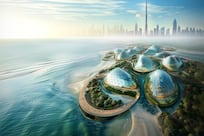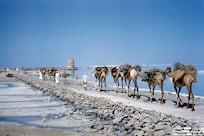Formula One teams live and breathe for fractions of a second. Even the slightest time saved is a cause for celebration. The majority of those time gains are made in the wind tunnel, which is why as much as a quarter of a team's annual budget is spent on endless hours of testing. Williams F1 has two, the first of which was opened in 1992, while the second came into being in 2004. Both run 24 hours a day, seven days a week with technicians monitoring the slightest tweaks around the clock.
As many as 2,500 parts a month will be tested on a 60 per cent scale model of the car driven by Nico Rosberg and Kazuki Nakajima - testing a full-scale car is currently banned by the FIA, the sport's governing body, in a bid to cut costs. Wind tunnel two is, in short, a monstrosity. Williams came up with the idea of a second tunnel in 2002 and, from inception to creation, took just over two years, a remarkable achievement.
Alex Burns, chief operating officer at Williams, comes from an aerospace background, which he admitted can look basic in comparison to the speed and finesse of F1. He explains: "It took just over two years from thinking we wanted to investigate the possibility to it being built, which is a good example of the speed of F1. In the aerospace industry, eight years would have been about right to do something similar - five years to decide and three years to build it."
The second wind tunnel at the team's headquarters on the edge of the leafy Oxfordshire village of Grove in England cost £20 million (Dh122 million). More than 2,600 square metres of earth was excavated and 560 tonnes of steel was used to create the space, which puts Williams at the cutting edge of F1 technology. Of the current crop of F1 teams, only Brawn GP - formerly Honda - has a newer wind-facility at its disposal.
The tunnel itself is a complex creation. The air circulates around it in a continuous closed loop, with massive fans pushing out air at speeds of up to 288kph. The air is sped up into the tunnel where it, in effect, blows over the car being tested, which travels on a steel belt at speeds of up to 110mph, the current maximum allowed by the FIA. Air is sucked out from the sides in a bid to replicate exact race conditions, while the scale model travels on is a turntable, which can twist as necessary to replicate F1 corners and the resultant crosswinds.
Being allowed access to a team's wind tunnel is akin to being shown its darkest secrets and Simon Wells, head of research and development at Williams and a veteran of nearly three decades of service at the team, takes me through the specific workings of the tunnel. As we enter the heart of the tunnel where the tests are carried, a member of his 70-strong workforce (in total, Williams boasts 520 employees) is fiddling with the left-rear wheel of the model.
The car itself - sitting on a steel conveyor belt, which costs £100,000 (Dh610,000) - is held in place by a giant fin held from the roof. And the car looks nothing like the one seen charging around the track at race weekends. On my visit, it looks like it is held together by hundreds of pieces of blue stone, pieces created elsewhere within the Williams factory, each one marked with the metal that has been used to create them.
Shortly after entering the tunnel, the team of technicians start up the tunnel once more, and the four of them sit behind computer screens to check the latest tweaks made to the cars. The sound is phenomenal as the air is blasted. Each test lasts just 20 minutes and may or may not prove successful. Wells explains: "There are a lot of things that are tested in a bid to make a gain so a lot of it is guess work in a sense, and there is an element of hit and miss in the whole process, although far more organised than that.
"The 20-minute slot normally gives enough time to obtain the information required and, if necessary, that run is repeated or else a slight tweak is made and so the process continues. What it does is create a reference point from where we can work." Gone are the days, though, where the team tends to experience eureka moments, although Wells argues that may well have happened at rivals McLaren this season where there has been a marked area of improvement halfway through the season.
"The gains being made are often so minute and you also don't know what the other teams are doing, so it's difficult to gauge how you've progressed," he says. "But we set our guidelines to know what we want to achieve." Williams has a reputation as a team punching well above their weight. A privateer team set up by Frank Williams in 1977, they lack the budget of the manufacturer teams like Ferrari and McLaren.
Despite that, the trophy cabinet at team headquarters boasts 113 race wins, seven driver titles and nine manufacturer crowns. Their bid to get back to winning ways - the team have not celebrated a victory since Brazil in the hands of Juan Pablo Montoya in 2004 - lies very much in the wind tunnel, so vital is the role played by aerodynamics. Aerodynamics only really came into being in F1 in the late 1960s and were not properly understood until the 1970s. Nowadays, it is the difference between winning and finishing last.
A more modern aspect of wind tunnel use is computational fluid dynamics, basically a predictive system done by computer to complement the experimental work done in the wind tunnel. The CFD work is based around two super computers, one of which is a beast of a model which can be seen through the windows of wind tunnel two. And all of that goes back to speed and getting things turned around as quickly as possible to improve the car as rapidly as the team's remit allows.
Burns, who oversees the running of the Williams wind tunnel and factory as a whole, says: "The time to market in every industry is the key and my job is to make that as easy as possible for my team. My customer is the race team and I need to make sure that parts are coming quickly enough in the factory ahead of each race. "I'm not too hands on in the day-to-day stuff, but I'll show my face when needs be. For example, we needed some parts specifically for Singapore so I got involved to help speed up that approach. It's all about speed and we can always get quicker as a team."
Back to the nuts and bolts of the wind tunnel, the team is increasingly turning its attention towards next year's car. Work is still currently being done on developing the car for Rosberg and Nakajima this season, but the majority of attention is already on the 2010 contender. Wells, who as head of R&D describes his job as getting as "much reliable data as possible from parts" and "likes to get involved in the day-to-day running of the wind tunnel".
An area of the wind tunnel that Wells would like to change is the FIA rulings in place that mean just 60 per cent scale models can be used. "The car behaves very differently compared to the full-size car," says Wells, "but those are the rules. We just have to get on with it." Whether a 60 per cent or full-size model is strapped in place to the wind tunnel conveyor belt, for Wells, Burns and their teams at Williams, the work is never ending as they bid to extricate the latest fraction of a second.





